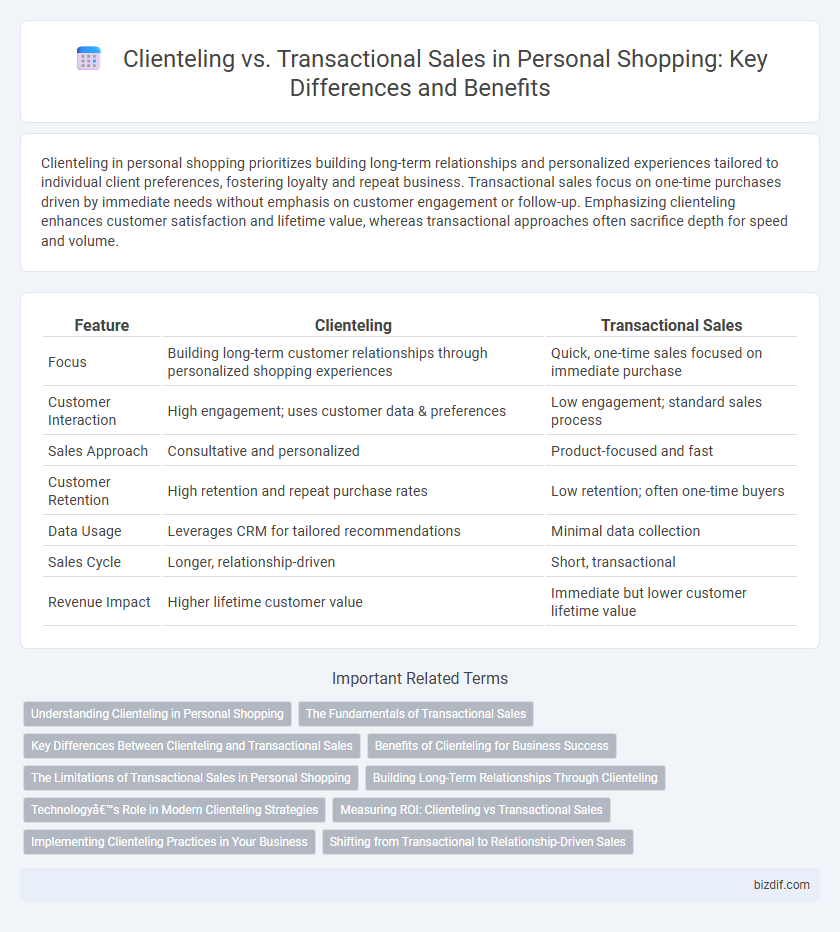Clienteling in personal shopping prioritizes building long-term relationships and personalized experiences tailored to individual client preferences, fostering loyalty and repeat business. Transactional sales focus on one-time purchases driven by immediate needs without emphasis on customer engagement or follow-up. Emphasizing clienteling enhances customer satisfaction and lifetime value, whereas transactional approaches often sacrifice depth for speed and volume.
Table of Comparison
| Feature | Clienteling | Transactional Sales |
|---|---|---|
| Focus | Building long-term customer relationships through personalized shopping experiences | Quick, one-time sales focused on immediate purchase |
| Customer Interaction | High engagement; uses customer data & preferences | Low engagement; standard sales process |
| Sales Approach | Consultative and personalized | Product-focused and fast |
| Customer Retention | High retention and repeat purchase rates | Low retention; often one-time buyers |
| Data Usage | Leverages CRM for tailored recommendations | Minimal data collection |
| Sales Cycle | Longer, relationship-driven | Short, transactional |
| Revenue Impact | Higher lifetime customer value | Immediate but lower customer lifetime value |
Understanding Clienteling in Personal Shopping
Clienteling in personal shopping emphasizes building long-term relationships by leveraging customer data such as preferences, purchase history, and feedback to deliver personalized experiences. Unlike transactional sales that focus solely on single purchases, clienteling uses tailored recommendations and consistent communication to increase loyalty and lifetime value. This approach enhances customer satisfaction and drives repeat business through a deep understanding of individual client needs and behaviors.
The Fundamentals of Transactional Sales
Transactional sales prioritize quick, one-time purchases driven by product features and price rather than customer relationships. The fundamentals focus on efficient point-of-sale interactions, inventory turnover, and maximizing volume rather than personalized service or long-term engagement. This approach often relies on promotional tactics and standardized sales scripts to close deals rapidly.
Key Differences Between Clienteling and Transactional Sales
Clienteling emphasizes building long-term relationships through personalized service and tailored recommendations based on client preferences and purchase history, whereas transactional sales focus on one-time purchases with minimal customer interaction. Clienteling fosters customer loyalty and repeat business by leveraging data-driven insights, while transactional sales prioritize quick, efficient sales volume without ongoing engagement. The key difference lies in clienteling's strategic approach to personalized experiences versus transactional sales' emphasis on immediate, product-centric transactions.
Benefits of Clienteling for Business Success
Clienteling enhances business success by fostering personalized customer relationships that increase loyalty and repeat sales. Businesses leveraging clienteling see higher average order values through tailored recommendations based on detailed customer profiles. This strategic approach enables retailers to differentiate themselves from competitors by delivering a superior, customized shopping experience that drives long-term profitability.
The Limitations of Transactional Sales in Personal Shopping
Transactional sales in personal shopping often emphasize one-time purchases, limiting the development of long-term customer relationships and personalized experiences. This approach neglects the tailored recommendations and trust-building essential for client retention and loyalty. Relying solely on transactional sales results in missed opportunities for upselling and cross-selling tailored to individual client preferences.
Building Long-Term Relationships Through Clienteling
Clienteling enhances personal shopping by prioritizing long-term relationships over one-time transactions, using detailed customer data to tailor personalized recommendations and experiences. This approach increases customer loyalty and lifetime value by anticipating needs and preferences, fostering trust and emotional connections. Brands leveraging clienteling benefit from higher retention rates and improved brand advocacy compared to purely transactional sales.
Technology’s Role in Modern Clienteling Strategies
Technology enhances modern clienteling strategies by enabling personalized customer profiles through CRM systems, allowing sales associates to tailor recommendations based on purchase history and preferences. Advanced analytics and AI-driven insights facilitate proactive engagement, improving customer retention and lifetime value. Mobile apps and digital communication tools streamline real-time interaction, making clienteling more efficient and effective than traditional transactional sales approaches.
Measuring ROI: Clienteling vs Transactional Sales
Measuring ROI in clienteling surpasses traditional transactional sales by emphasizing long-term customer value and repeat purchase frequency rather than just immediate sales volume. Clienteling strategies leverage personalized interactions and customer data to increase lifetime value, leading to higher retention rates and amplified average order value. In contrast, transactional sales focus on single purchases, often resulting in lower customer engagement and limited insight into buying behavior.
Implementing Clienteling Practices in Your Business
Implementing clienteling practices in your business enhances customer loyalty by fostering personalized interactions based on detailed purchase history and preferences, unlike transactional sales which focus solely on one-time purchases. Utilizing CRM tools enables tailored product recommendations and proactive follow-ups, increasing repeat sales and customer lifetime value. Training staff to build rapport and track customer data transforms the shopping experience into a relationship-driven process rather than a simple exchange.
Shifting from Transactional to Relationship-Driven Sales
Clienteling transforms personal shopping by prioritizing relationship-driven sales over one-time transactional interactions, enhancing customer loyalty and lifetime value. This approach leverages data analytics and personalized communications to deliver tailored experiences that meet individual client preferences and needs. Retailers embracing clienteling see increased repeat purchases and stronger emotional connections, driving sustainable business growth beyond mere transactional metrics.
Clienteling vs Transactional sales Infographic

 bizdif.com
bizdif.com